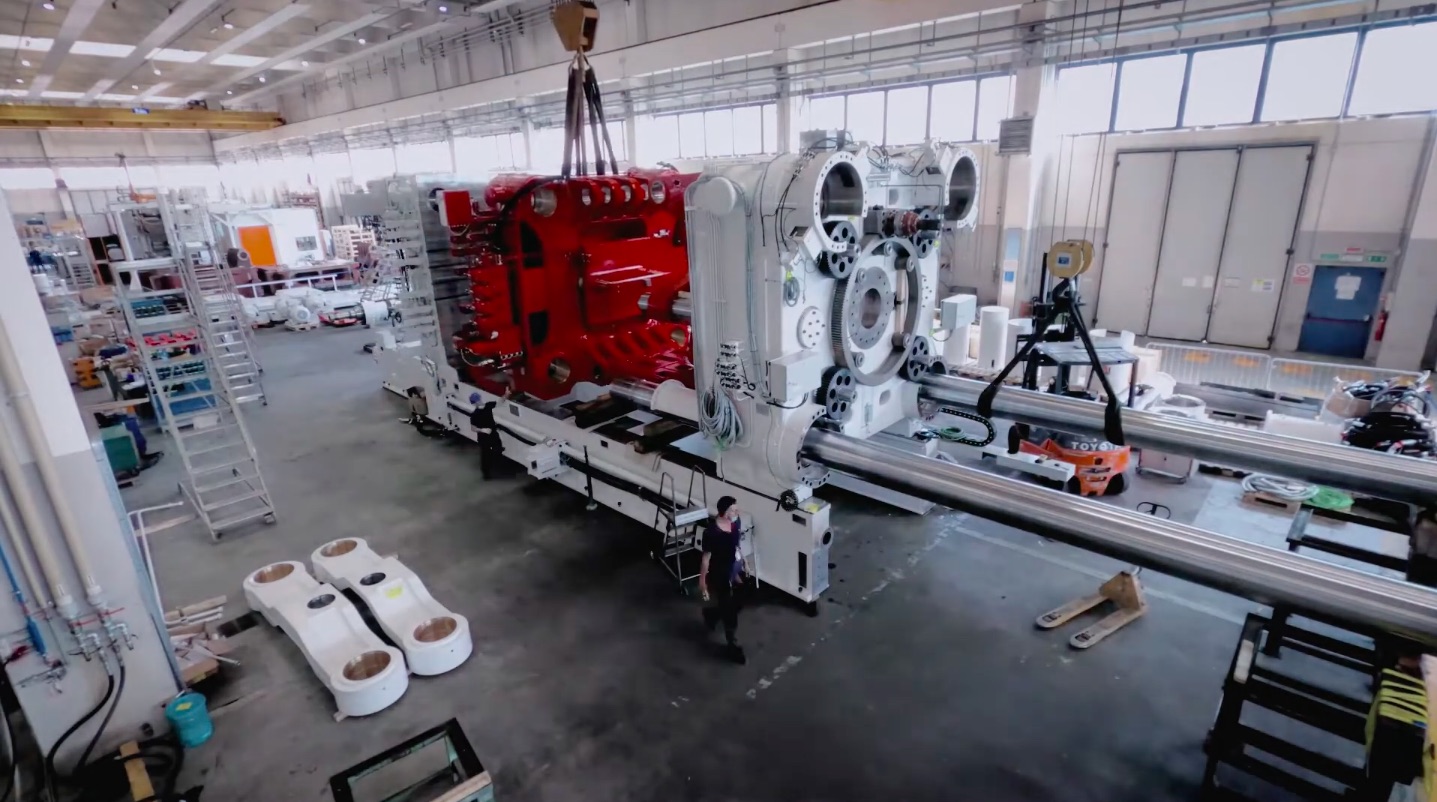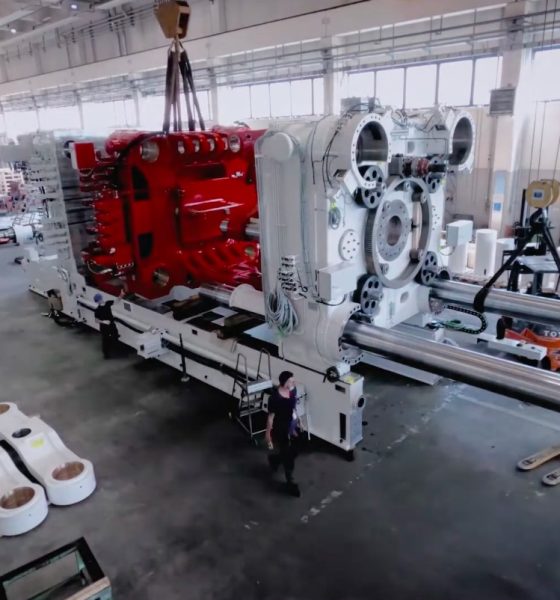

News
Tesla begins Giga Press manufacturing at Fremont factory, first sighting in action
A recent flyover of Tesla’s Fremont production factory in Northern California has revealed the first looks at the all-too-elusive Giga Press as it was spotted in action. The Giga Press is a machine Tesla is installing at its manufacturing plants to increase production efficiency and improve vehicle build quality.
A flyover of the plant from YouTuber Gabeincal shows several portions of the Fremont factory, including offloading recently completed vehicles into haulers for customer delivery. Looking for clues that would confirm details of the rumored Model S and Model X refresh, Gabeincal stumbled upon something else: the Giga Press.
The “house-sized” casting machine was installed at Tesla’s Fremont Factory in August 2020, a project that was confirmed by Elon Musk in a Tweet with @WholeMarsBlog. “Will be amazing to see it in operation,” Musk wrote. Biggest casting machine ever made. Will make rear body in a single piece, including crash rails.” The machine is 64 feet long, 17 feet tall, and weighs 410 tons, according to IDRA, the machine’s manufacturer.
Will be amazing to see it in operation! Biggest casting machine ever made. Will make rear body in a single piece, including crash rails.
— Elon Musk (@elonmusk) August 13, 2020
Tesla has long planned for the inclusion of new processes that will make manufacturing vehicles easier. It is the key to delivering 1 million vehicles with only a few production plants in operation in 2021, even though two more are expected to begin operation later this year.
The Giga Press is part of Tesla’s global plan to increase production efforts across its manufacturing facilities. It has already been installed in Giga Shanghai, where Model Y production has recently started, and in Giga Berlin, where the same vehicle will be prioritized when production begins later this year. Parts of the Giga Press have also arrived in Austin at Tesla’s Giga Texas facility. It is a major step in the right direction for Tesla as its EVs are ahead in technology and battery quality, but manufacturing density is where Tesla lacks.
Other car companies build 20 million vehicles a year, and Tesla is just a newcomer in the grand scheme of the automotive industry. In order to catch up on years of experience, Tesla has refined its focus to improving manufacturing. The Giga Press is a way for Tesla to build more vehicles using fewer parts, it will also cut down on overall production time, allowing the company to build more vehicles every year.
ALSO READ:
Fascinating look at Tesla’s mammoth ‘Giga Press’ machine being assembled
The inspiration for the Giga Press was the Hot Wheels version of Tesla’s EVs. Musk said that “Sandy (Munro) accurately pointed out, the rear of the Model 3 looks like a patchwork quilt. It’s not great…The current version of the Model Y has basically two big high-pressure die-cast aluminum castings that are joined. Later this year, we will transition a single piece casting that also integrates the two rear crash rails.”
As Tesla continues to battle production efficiencies in its mission to expand and scale production, the Giga Press operation in Fremont will revolutionize the manufacturing processes for its vehicles moving forward.
Check out Gabeincal’s video of the Fremont Giga Press in action below. It begins at 5:15 and lasts around a minute and a half.
H/t: @TeslaNY on Twitter

News
Man credits Grok AI with saving his life after ER missed near-ruptured appendix
The AI flagged some of the man’s symptoms and urged him to return to the ER immediately and demand a CT scan.

A 49-year-old man has stated that xAI’s Grok ended up saving his life when the large language model identified a near-ruptured appendix that his first ER visit dismissed as acid reflux.
After being sent home from the ER, the man asked Grok to analyze his symptoms. The AI flagged some of the man’s symptoms and urged him to return immediately and demand a CT scan. The scan confirmed that something far worse than acid reflux was indeed going on.
Grok spotted what a doctor missed
In a post on Reddit, u/Tykjen noted that for 24 hours straight, he had a constant “razor-blade-level” abdominal pain that forced him into a fetal position. He had no fever or visible signs. He went to the ER, where a doctor pressed his soft belly, prescribed acid blockers, and sent him home.
The acid blockers didn’t work, and the man’s pain remained intense. He then decided to open a year-long chat he had with Grok and listed every detail that he was experiencing. The AI responded quickly. “Grok immediately flagged perforated ulcer or atypical appendicitis, told me the exact red-flag pattern I was describing, and basically said “go back right now and ask for a CT,” the man wrote in his post.
He copied Grok’s reasoning, returned to the ER, and insisted on the scan. The CT scan ultimately showed an inflamed appendix on the verge of rupture. Six hours later, the appendix was out. The man said the pain has completely vanished, and he woke up laughing under anesthesia. He was discharged the next day.
How a late-night conversation with Grok got me to demand the CT scan that saved my life from a ruptured appendix (December 2025)
byu/Tykjen ingrok
AI doctors could very well be welcomed
In the replies to his Reddit post, u/Tykjen further explained that he specifically avoided telling doctors that Grok, an AI, suggested he get a CT scan. “I did not tell them on the second visit that Grok recommended the CT scan. I had to lie. I told them my sister who’s a nurse told me to ask for the scan,” the man wrote.
One commenter noted that the use of AI in medicine will likely be welcomed, stating that “If AI could take doctors’ jobs one day, I will be happy. Doctors just don’t care anymore. It’s all a paycheck.” The Redditor replied with, “Sadly yes. That is what it felt like after the first visit. And the following night could have been my last.”
Elon Musk has been very optimistic about the potential of robots like Tesla Optimus in the medical field. Provided that they are able to achieve human-level articulation in their hands, and Tesla is able to bring down their cost through mass manufacturing, the era of AI-powered medical care could very well be closer than expected.
News
Tesla expands Model 3 lineup in Europe with most affordable variant yet
The Model 3 Standard still delivers more than 300 miles of range, potentially making it an attractive option for budget-conscious buyers.

Tesla has introduced a lower-priced Model 3 variant in Europe, expanding the lineup just two months after the vehicle’s U.S. debut. The Model 3 Standard still delivers more than 300 miles (480 km) of range, potentially making it an attractive option for budget-conscious buyers.
Tesla’s pricing strategy
The Model 3 Standard arrives as Tesla contends with declining registrations in several countries across Europe, where sales have not fully offset shifting consumer preferences. Many buyers have turned to options such as Volkswagen’s ID.3 and BYD’s Atto 3, both of which have benefited from aggressive pricing.
By removing select premium finishes and features, Tesla positioned the new Model 3 Standard as an “ultra-low cost of ownership” option of its all-electric sedan. Pricing comes in at €37,970 in Germany, NOK 330,056 in Norway, and SEK 449,990 in Sweden, depending on market. This places the Model 3 Standard well below the “premium” Model 3 trim, which starts at €45,970 in Germany.
Deliveries for the Standard model are expected to begin in the first quarter of 2026, giving Tesla an entry-level foothold in a segment that’s increasingly defined by sub-€40,000 offerings.
Tesla’s affordable vehicle push
The low-cost Model 3 follows October’s launch of a similarly positioned Model Y variant, signaling a broader shift in Tesla’s product strategy. While CEO Elon Musk has moved the company toward AI-driven initiatives such as robotaxis and humanoid robots, lower-priced vehicles remain necessary to support the company’s revenue in the near term.
Reports have indicated that Tesla previously abandoned plans for an all-new $25,000 EV, with the company opting to create cheaper versions of existing platforms instead. Analysts have flagged possible cannibalization of higher-margin models, but the move aims to counter an influx of aggressively priced entrants from China and Europe, many of which sell below $30,000. With the new Model 3 Standard, Tesla is reinforcing its volume strategy in Europe’s increasingly competitive EV landscape.
News
Tesla FSD (Supervised) stuns Germany’s biggest car magazine
FSD Supervised recognized construction zones, braked early for pedestrians, and yielded politely on narrow streets.

Tesla’s upcoming FSD Supervised system, set for a European debut pending regulatory approval, is showing notably refined behavior in real-world testing, including construction zones, pedestrian detection, and lane changes, as per a recent demonstration ride in Berlin.
While the system still required driver oversight, its smooth braking, steering, and decision-making illustrated how far Tesla’s driver-assistance technology has advanced ahead of a potential 2026 rollout.
FSD’s maturity in dense city driving
During the Berlin test ride with Auto Bild, Germany’s largest automotive publication, a Tesla Model 3 running FSD handled complex traffic with minimal intervention, autonomously managing braking, acceleration, steering, and overtaking up to 140 km/h. It recognized construction zones, braked early for pedestrians, and yielded politely on narrow streets.
Only one manual override was required when the system misread a converted one-way route, an example, Tesla stated, of the continuous learning baked into its vision-based architecture.
Robin Hornig of Auto Bild summed up his experience with FSD Supervised with a glowing review of the system. As per the reporter, FSD Supervised already exceeds humans with its all-around vision. “Tesla FSD Supervised sees more than I do. It doesn’t get distracted and never gets tired. I like to think I’m a good driver, but I can’t match this system’s all-around vision. It’s at its best when both work together: my experience and the Tesla’s constant attention,” the journalist wrote.
Tesla FSD in Europe
FSD Supervised is still a driver-assistance system rather than autonomous driving. Still, Auto Bild noted that Tesla’s 360-degree camera suite, constant monitoring, and high computing power mark a sizable leap from earlier iterations. Already active in the U.S., China, and several other regions, the system is currently navigating Europe’s approval pipeline. Tesla has applied for an exemption in the Netherlands, aiming to launch the feature through a free software update as early as February 2026.
What Tesla demonstrated in Berlin mirrors capabilities already common in China and the U.S., where rival automakers have rolled out hands-free or city-navigation systems. Europe, however, remains behind due to a stricter certification environment, though Tesla is currently hard at work pushing for FSD Supervised’s approval in several countries in the region.








